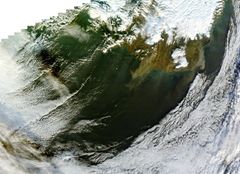According to the weather forecast, we should expect high levels of particulate matter pollution in Reykjavik - and most other towns - in Iceland this New year's eve.
In a manuscript (already submitted), I and co-authors, we show that the PM-pollution levels can reach 2374 μg m-3 just after midnight if the weather is calm, but if there is strong wind (and rain) the levels can be as low as <500 μg m-3.
Happy new year !
2009-12-30
2009-12-29
2009-12-15
2009-11-23
Dust storms in Iceland 20091122
This Sunday dry northerly winds stirred up dust storms in Iceland. Beautiful images from the NASA's MODIS satellites, Terra and Aqua, are below:
At 13.15 on Sunday.
At 13.30 on Sunday.
2009-09-15
Dust storm in the Eastern part of the country
Today reports in the news indicate that there is a strong dust storm limiting view in Egilsstadir, east Iceland.
The following satellite image clearly shows where the dust comes from, and how it is carried in over Egilsstadir (northern part of the narrow lake).
The following satellite image clearly shows where the dust comes from, and how it is carried in over Egilsstadir (northern part of the narrow lake).
Retreating glaciers leave behind large deposits of fine material that can easily be eroded.
2009-05-18
Glaciology field trip 2009
Field trip in Glaciology, joint with Glacial geology, May 15 - 17, 2009.
We went to Gígjökull, an outlet glacier on the northern side of Eyjafjallajökull, where dead ice and a lagoon are impressive features.
Then there was a stop at Sólheimajökull, which is retreating several tens of meters per year since 1996; 134 m in 2008.
On Saturday, May 16, we stopped by Kvíárjökull, and then onwards to Jökulsárlón. At Jökulsárlón part of the group did GPS measurements between the coast and the lake, while the other part explored the other lagoons in the neighborhood.
On Sunday we went to Skaftafell, and walked to the terminus of Skaftafellsjökull.
We were very lucky with the weather, as the pictures below (you can click to get the album) show !
Cheers, Throstur.
<|>
Cheers, Throstur.
<|>
2009-05-13
High levels of PM10 and O3
Today high levels of PM10 pollution are measured in Reykajvik.
The main source is sandstorms and polluted air from Europe, as is often the case, with sandstorms being responsible for 1/3 of above health limit cases in 2008, and polluted air from a long distance for 1/6 of the cases.
2009-05-01
Water at the base of glaciers
The research fund of Landsvirkjun awarded a grant to study the water at the base of glaciers.

This project aims at following the routes and distribution of water at the base of glaciers.
Connected with that are also considerations about water pressure, and that is then again related to glacier sliding.
Thank you Landsvirkjun !
Pollution and climate
Pollution and climate is a loose translation of the title of a project that just got funding from Reykjavik Energy (Orkuveitan).

This projects mainly deals with the natural sources of particulate matter pollution, and the effects of weather on the concentration, with the aim of understanding the sources and sinks to be able to model the strength of pollution.
Thank you Reykjavik Energy

2009-04-19
Ice2sea
The aim of this large project is to improve predictions of Greenlands contribution to sea level changes (rise) in the future.
Our contribution will mainly to provide data and theoretical estimates of the effects of water on sliding of glaciers.
This will be a challenging and interesting work !
Subscribe to:
Posts (Atom)


